Bullfighting in Spain: The Only Real Fighter is the Bull

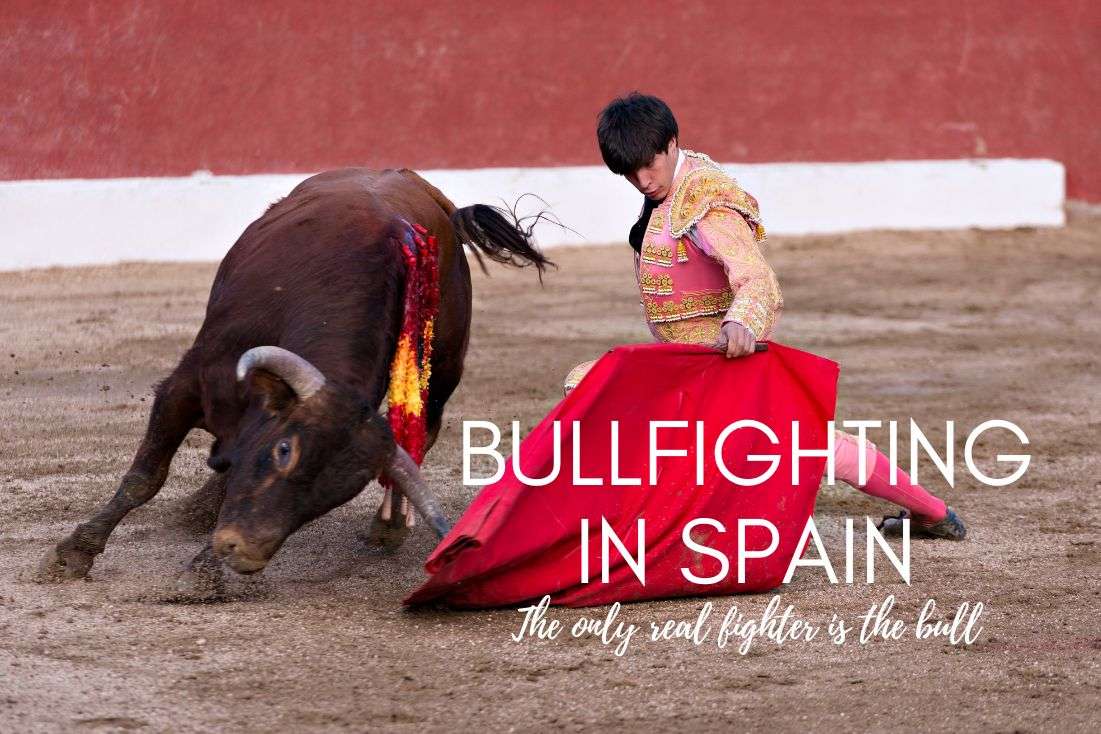
Spoiler alert: I think bullfighting is an outdated pastime that Spain only holds on to because that’s what they do – keep tradition. Must. Keep. Tradition (said in Neanderthal voice)! It’s torturing an animal for public entertainment, sit down!
Have you heard the crazy myths going around trying to prove that bullfighting is totally fine? Like these:
The bull deserves to die because it’s aggressive! Fighting bulls are bred so that they are reactive and aggressive. It’s a choice of the humans for the bulls to be aggressive. And like many choices humans make, it is crap.
The bull feels no pain! Are you kidding me? Read a biology book.
It is a fair fight! Ok, maybe you don’t know how bullfights work. Read on and then reassess.
You might also be interested in reading:
- Andalusia Itinerary: Southern Spain in 10 Days
- Barcelona Itinerary: 5 days in Gaudí’s Metropole (with day trips)
- All You Need to Know about Spanish Tapas (+Restaurant Tips)
- The 10 Best Museums in Spain’s Top Cities
- The 16 Most Beautiful Beaches in Spain
History of bullfighting: It’s just for fun
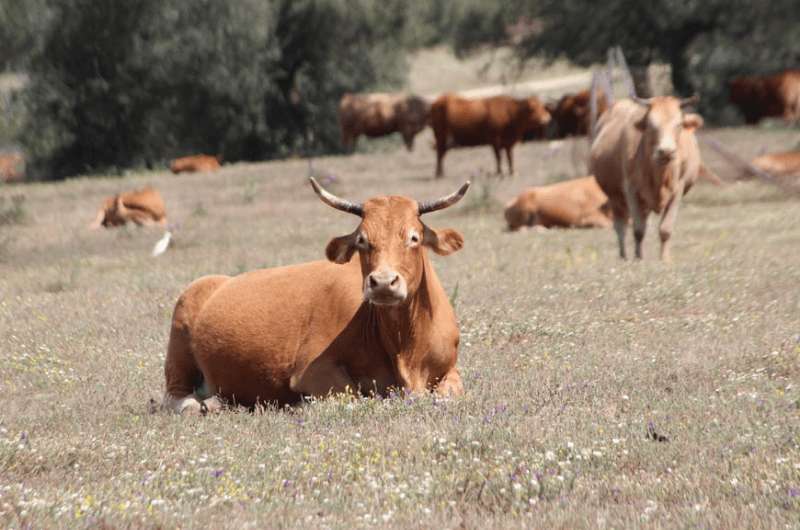
Just look at that cute face
Bullfighting has been a thing since forever, with the Epic of Gilgamesh (ancient Mesopotamia) probably being the first written record of a bullfight. The Romans were known to find human vs. animal fights and hunting games super fun.
Fighting bulls was also likely an alternative to gladiator matches, which were banned for a short period of time in Rome’s history. That, along with the sacrificial killing of bulls in a popular Roman mystery religion, Mithraism, probably had to do a lot with bullfighting being brought to Spain. Read more about the many plot twists of Spain’s history here.
Bullfights looked a lot different before, with the matador (person doing the killing) on horseback. Some sources say that these fights with a bull were meant to be battle practice for wars and such.
Most of the time, though, it was just a gory pastime for the rich. At arenas, there is always a special spot for nobles to sit and feel important. To this day, there is always a dignitary of some sort in the special seats, like a city official. They get saluted by the participants of the bullfight and have the honor of starting the event.
The basics of a Spanish bullfight
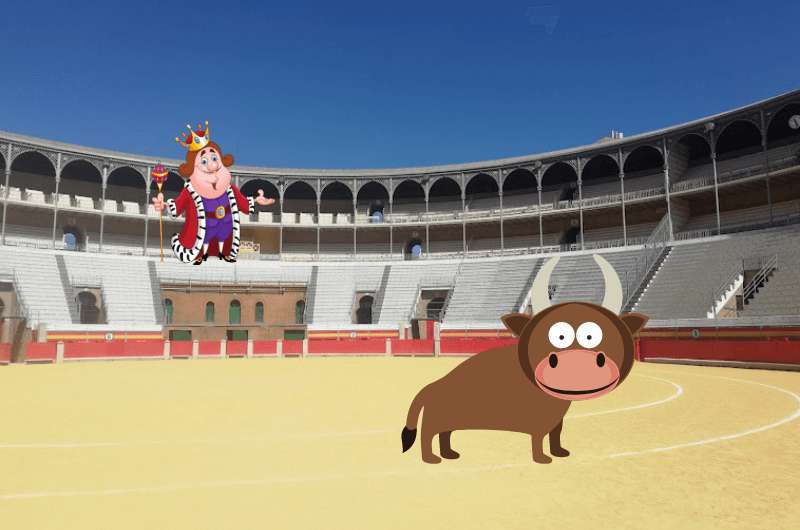
It's simply not fair...
In short, it looks like a disadvantaged, bloodied animal getting taunted and stabbed to death by men in leggings and shiny jackets.
This is how a Spanish bull fight works:
The word corrida means a bullfighting event, traditionally it is three matadors who each fight two bulls. Each individual bullfight lasts about 20 minutes.
A match has 3 parts, like a theater play, which it basically is (except for the bull, he dies for real). Let’s introduce the actors: the matador is the lead character and will be wearing the flashiest costume, embellished with golden details. In the supporting roles – each matador has six buddies to help him out – are two picadores on horseback, three banderillos and one mozo de espadas who brings the matador his swords (because there is a fake one and a real one).
Before the show, all participants enter the arena and salute the presiding dignitary. A band is playing music. The atmosphere is full of tension and excitement. The matador is wearing a cape, feeling like superman.
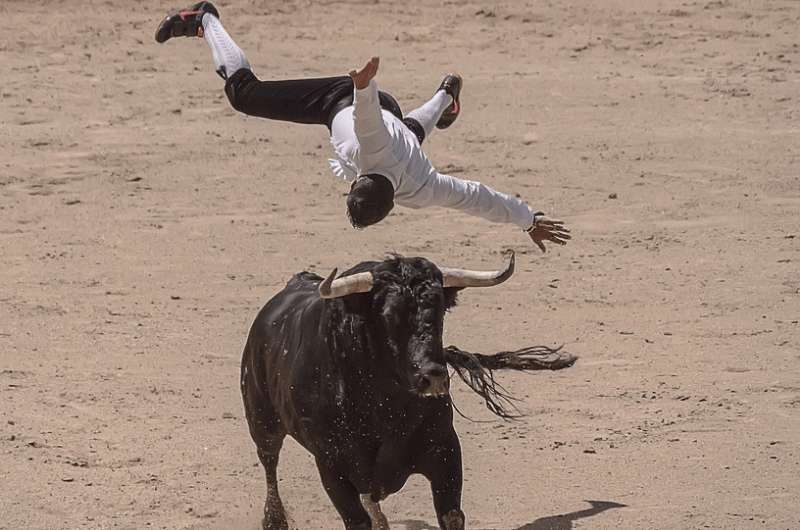
I believe I can fly...
Meanwhile, the bull has been locked up in a tiny dark pen for hours, getting his eyes smeared with Vaseline, ears stuffed with cotton, and doped up on sedatives, or some other wack means of restricting his senses and orientation. A whole other level of tension. Seriously, just knowing this, doesn’t it feel like the wrong kind of entertainment?
Our top tips for bullfighting in Spain:
- Tour one of the oldest bull rings in the world, Ronda’s Plaza de Toros
- For an interactive tour, check out Granada’s Plaza de Toros
- Skip the bulls altogether and get chased by a huge ball at Boloencierro
The three stages of a bullfight
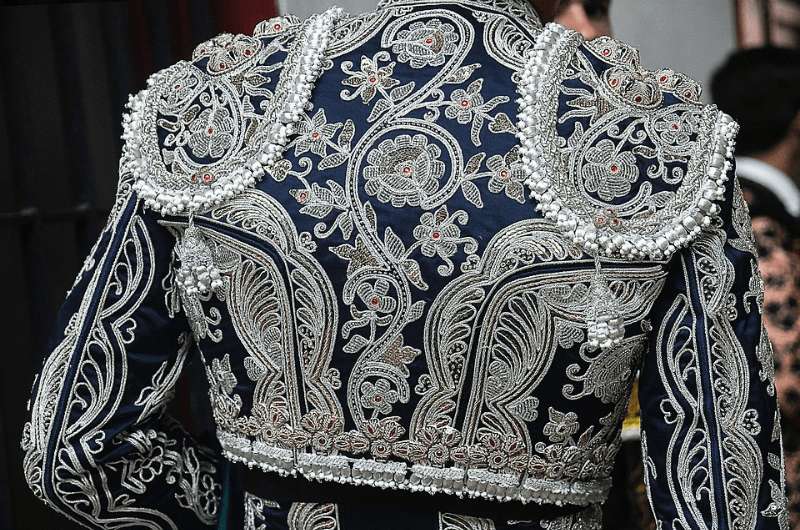
The fancy coat. Add some leggings and you are good to go stab some bulls.
When the first stage, the tercio de varas, starts, the bull pen opens and the bull charges out. He usually gets stabbed for the first time on his way into the arena with a rosette in the colors of the farm the bull was bred on.
During this scene, the banderillos get the bull to charge and chase them, allowing the matador to observe the bull for his reactions and behavior. Basically, the matador gets to see his opponent’s strengths and weaknesses. Interestingly, a fierce bull is more predictable than a scared bull that often changes direction suddenly and weaves when running instead of going in a straight line. A large, magenta and gold cape is used to get a reaction out of the confused bull.
During this phase, the matador shows off his tricks and gets labeled as brave or cowardly.
Then the picadores ride in on their horses, which are blindfolded and probably scared shitless, shoving a lance or three behind the bull’s neck. This is supposed to hurt the bull into carrying its head lower than usual, which protects the matador’s body. The horns are aiming at the matador’s legs, not his body. The bloodshed begins.
Fun fact about bullfighting horses: Before the 1930s, the horses the picadores rode didn’t wear any armor and thousands of them died every year in the first stages of bullfights. There were many more horses killed than bulls. For this reason, older and less valuable horses were used, because they were disposable. The horses’ eyes are covered because no horse in its right mind would run around in an arena with a charging bull.
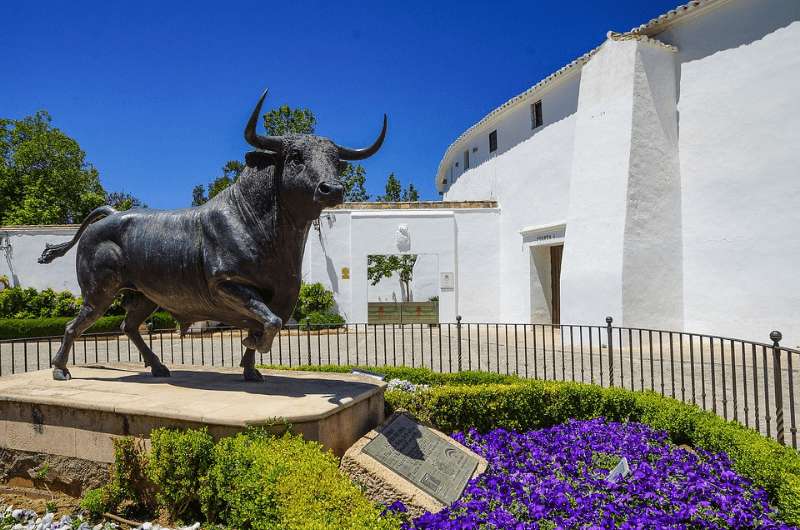
I’m glad I’m out here and not in there. At the arena in Ronda.
The tercio de banderillas is the next stage, one where the bull is further stabbed and left to bleed to prepare him for the heroic fight with the matador in the last scene. Can you see how this is messed up?
The three banderillos each try to plant 2 barbed, sharp sticks into the bull’s shoulders. Of course, they do it in an entertaining way, making it seem exciting with a lot of jumping up in the air. The bull, already tired and hurt, often slows down after the first round and (probably) just wants to give up and go home. So this round is meant to make him angry and agitated again so the show can go on. But also weak enough thanks to the wounds and blood loss that the matador actually has a chance to kill it.
And finally, in the tercio de muerte, the matador re-enters to finish the poor animal off. He is now carrying a small red cape and a fake sword. Bulls can’t see red, so it’s just the movements of the cape that attract them. The real reason the cape is red is because the bull’s blood is less visible on it. Killing a bull is entertaining and all, but we wouldn’t want to gross out the audience by reminding them that there is real blood, I guess.
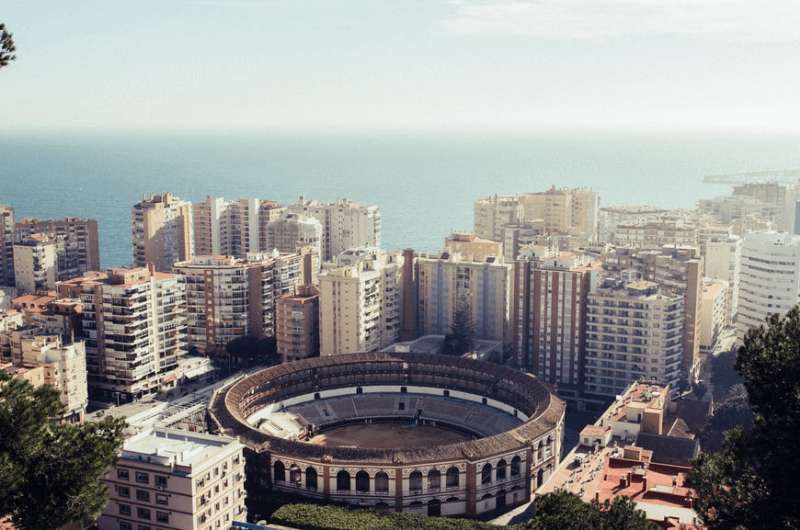
Arena in Malaga
This being a show and the matador being an actor more than anything else, he can’t carry a real sword during all the performing. I guess his arm would get tired or he would accidentally cut himself. So for the first part of this, the matador has a wooden or aluminum sword.
When he’s done with his choreography, his assistant gets him a steel sword. With this, he attempts to quickly kill the bull by piercing its heart or aorta, but that often doesn’t happen, being the bull is moving and all. So the matador makes repeated attempts at this and the death isn’t quick and simple. Sometimes he changes his sword to a dagger to get a better chance of finally putting the animal out of its misery. That doesn’t sound like torture or anything, right?
Last but not least, horses are brought in to drag the bull’s dead body out of the arena, leaving behind a bloody path in the sand. The matador feels manly, everyone claps, the more sensitive souls in the audience try not to throw up, and everyone goes home for some tapas.
What a nice tradition! I think I’ll bring my kids next time! When I have some.
Tip: If you forgot your kids at home, check out the adults-only Axel Hotel in Madrid.
Fun fact: Sometimes, the audience is so impressed with the bull’s fight for his life, that they ask the bull is pardoned. If this happens, it is done with much fanfare and the matador gets the honor to lead the bull out of the arena ceremoniously, and then the bull is slaughtered anyway. Just out of sight. And his mother is too, because we couldn’t risk another strong bull to be born, now could we.
Bullfighting in Spain: The popularity is dwindling
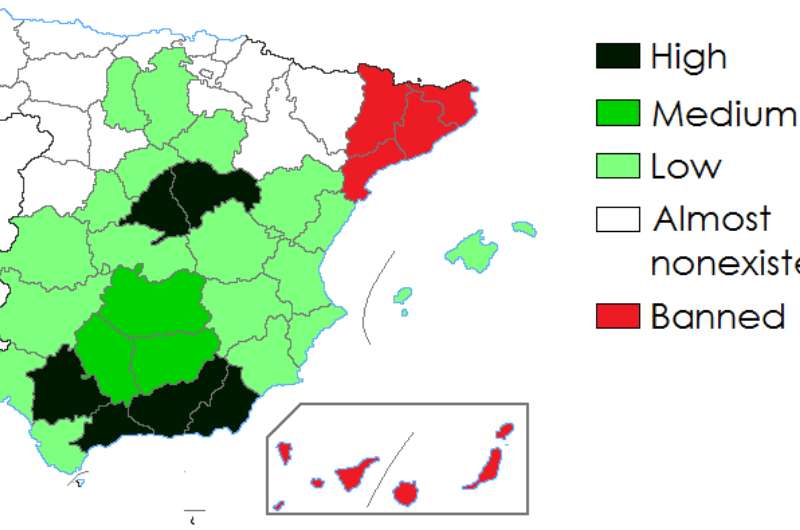
Prevalence of bullfighting in individual Spanish regions (2012). Image source: Wikipedia
Spain regards bullfighting as an art and has described it as a national heritage, anchoring it in their national laws, making it impossible for individual regions to ban it. Spain is keeping bullfighting legal, holding onto it for dear life. It has about 600 bullrings throughout the country to show for it. Many of those aren’t being used to hold corridas anymore, most often being turned into either museums or event halls.
The more traditional south, Andalusia, is where the tradition’s roots are particularly strong and stubborn, though Madrid is regarded as the bullfighting capital of Spain. The northern regions mostly don’t care for bullfighting at all.
Catalonia (the region where Barcelona is located) issued a ban on bullfighting in 2010 that was overturned by Spain’s Constitutional Court in 2016. Even so, bullfighting is not being practiced in the region and the Las Arenas bull ring in Barcelona was turned into a shopping mall in 2011.
The Canary Islands also have a type of ban, and the Balearic Islands are trying to ban at least the killing at the end. But that, said the court, is an important part of the fight, and cannot be banned. So instead, they put in place extra strict regulations surrounding the event, hoping that by making organizers jump through hoops, interest in organizing bullfights will naturally go down.
Tip: Read up on Mallorca and make it your next vacation destination! Hotel Villa Chiquita will make your stay a dream.
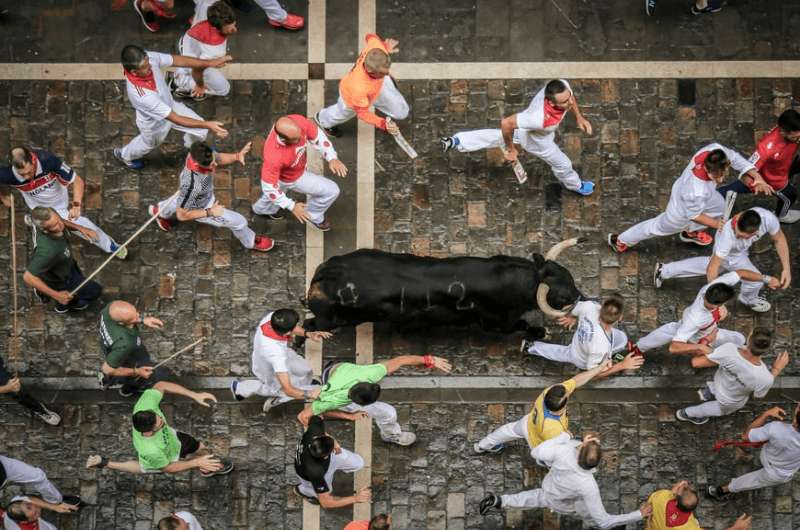
The Pamplona Bull Run. The bulls are led to the arena where they are, wait for it… killed. So not just a fun little run.
In 2018, there were 1500 bullfights held in the country, a 60% decrease from 10 years prior. Only 8% of the population attended a bull-related event in 2018, with only a small fraction of that being an actual bullfight. If this were a business, it would be shut down a long time ago! The older, more conservative and less educated parts of the population are the ones that are holding on to this “sport” the most.
But it’s the tourists that help keep this tradition alive, because the controversial bullfights attract visitors’ interest. Don’t be that guy. Coming from a country where the shittiest tabloid is the most read newspaper in the country, I understand that people like a spectacle. The people like a good shit storm, right? Sensation is key, there’s psychology behind it.
Just know that if you see a bullfight out of curiosity, you are one of thousands that do so (almost nobody wants to see another bullfight ever again after their first curiosity visit). And maybe if you didn’t go, they’d rather turn the arena into a museum. Instead, I recommend visiting an arena as part of a tour (see below), or choosing a completely different kind of event, like the Running of the Ball north of Madrid. The giant balls replaced the bulls in a run that otherwise resembles the famous event from Pamplona. Don’t be fooled, a 440 lb (200 kg) ball can squash a runner almost as well as a raging bull.
Bullfighting arenas in Spain
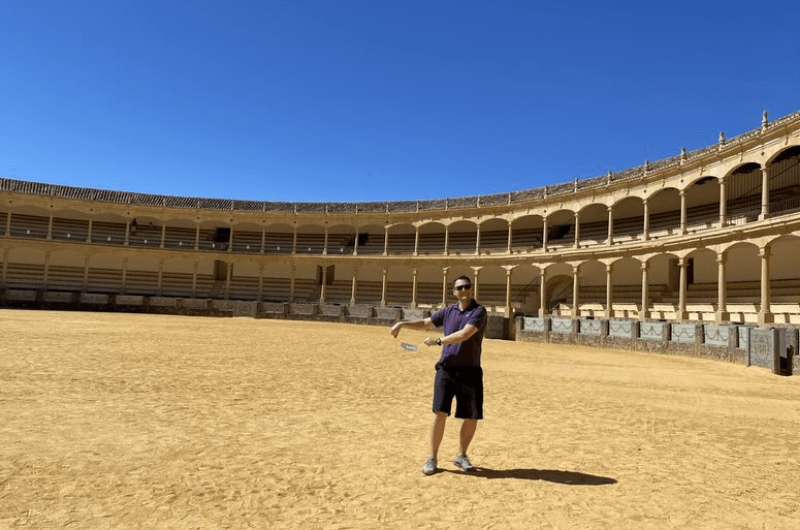
Bravely fighting covid in Ronda’s arena.
Even though bullfighting is slowly but (hopefully) surely nearing its end. Bull arenas are often beautiful buildings that are worth a visit just to admire the architecture. Almost every town has its own arena, so you won’t have any shortage of arenas to admire. The oldest in the world are in Andalusia. Both are from the 18th century.
One is in a little town called Ronda, high up on a cliff. This is where modern bullfighting was born, with matador Pedro Romero deciding to fight the bull on foot instead of on a horse, as was the norm until then. A festival named after him, the Feria Goyesca de Pedro Romero, takes place every September.
The other is in Andalusia’s largest city, Seville. It took 120 years to complete the structure and it is considered one of the most complex and beautiful bullrings in Spain. The most important bullfights of the year are held during the Feria de Abril.
Tip: Ronda can easily be done as a day trip from Seville or Malaga, which most visitors fly into. But to cut back on travel times in one day, stay a night. There is even a hotel in Ronda, the Catalonia Ronda, that has a view right into the famous bullring!
Another bullfighting arena that had a great, informative tour, was the one in Granada. The tour is interactive, letting visitors try on matadors’ costumes and giving an almost convincing explanation as to why anyone would want to fight bulls like this in the first place.
With almost 24,000 seats, Madrid’s Las Ventas Arena is the largest in the country and third largest in the world. Compare that to the capacity of 41,000 in the world’s largest arena, the Plaza de Toros in Mexico. It is built in Moorish style and has several levels of seating, or patios. Along with bullfights and tours, concerts are sometimes held there as well. The Beatles, Diana Ross and Coldplay have all had a tour stop there.
All of the arenas above are still being actively used for bullfighting, but since you can also take a tour and learn about the history of bullfighting and take a look around the admittedly awesome structures without a bull getting killed – why wouldn’t you? It’s a win win!
Head into the future
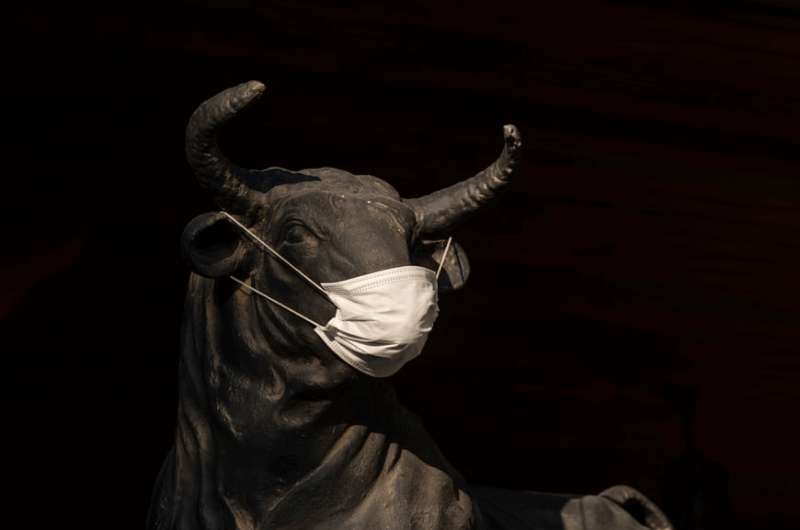
Hoping for covid to continue interfering with bullfights in 2022
Keeping traditions alive just for the sake of keeping traditions alive is stupid at best. It’s up there with the grind, the similarly gross traditional whale hunt of the Faroe Islands.
Aren’t we supposed to evolve and do better? Not hold on to something regardless of how ethical it is, just because they did it a long time ago too. They did a lot of things back then, but you don’t see anyone raising unwanted children as slaves or hanging out together in community toilets anymore.
Just move on the 21st century already. And to do something traditionally Spanish, have a paella, a siesta, a really late-night dinner and talk loudly for hours! No bloodshed necessary.
This post may contain affiliate links. We earn a small commission if you make bookings through my links, at no additional cost to you. This helps us keep this blog free, thank you!










Comments | Thoughts? Give us a shout!